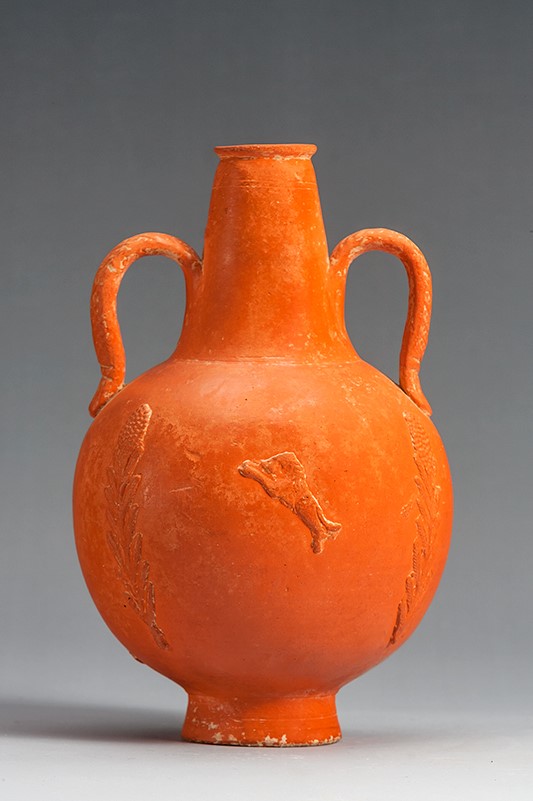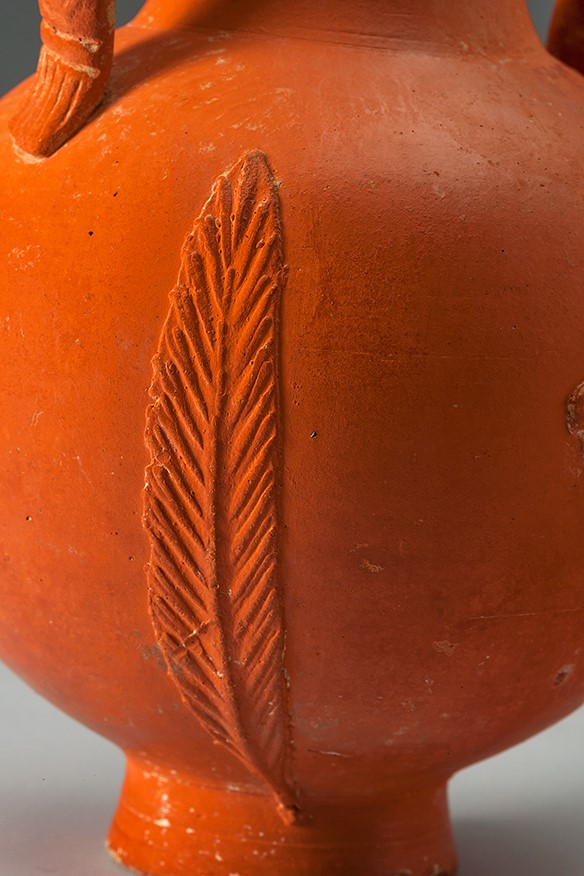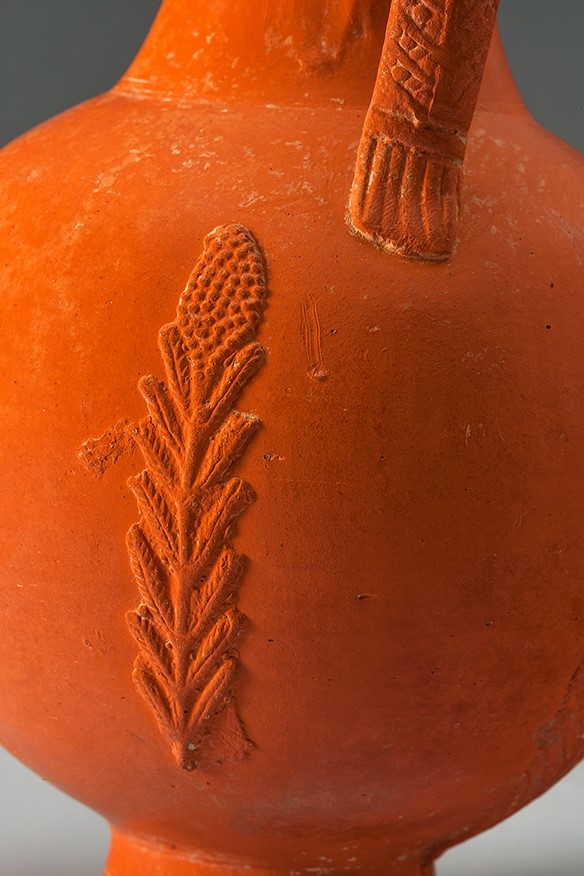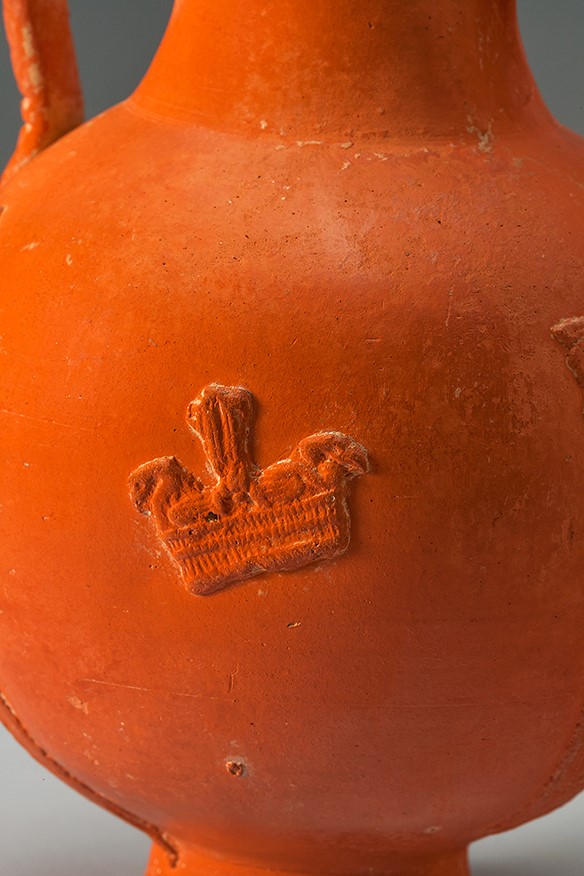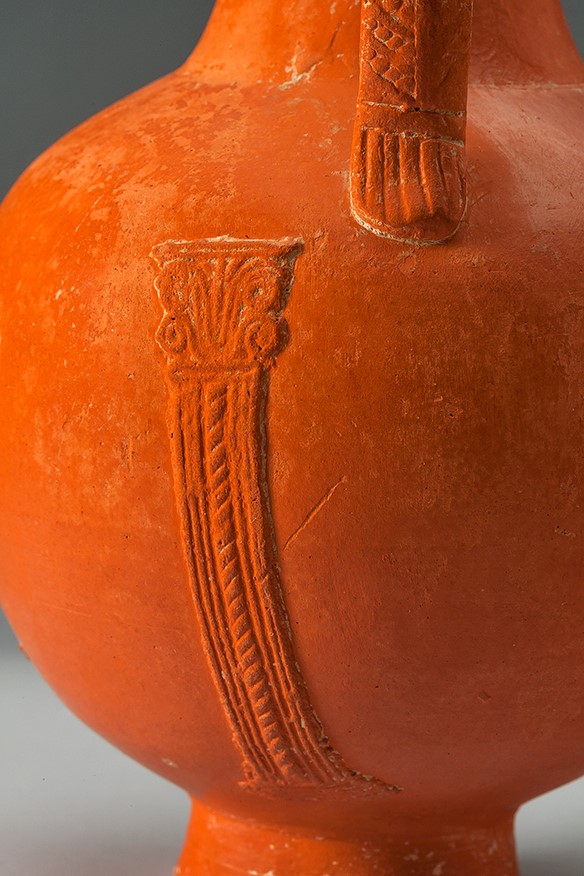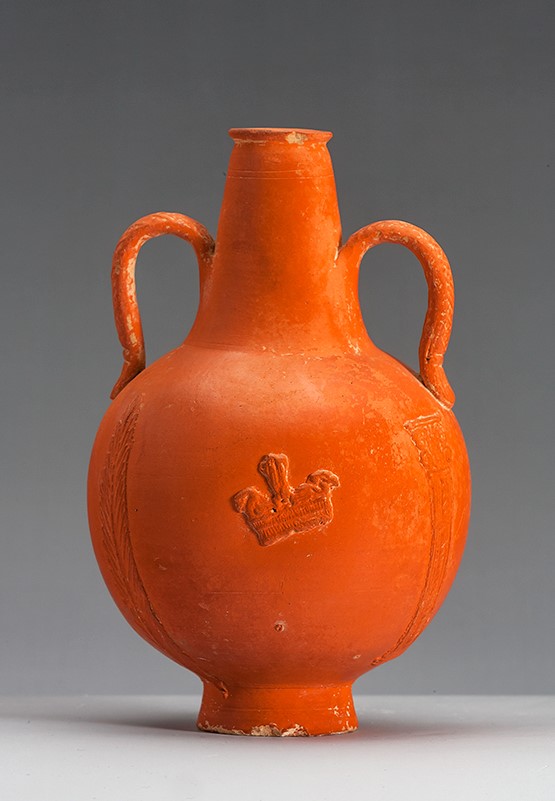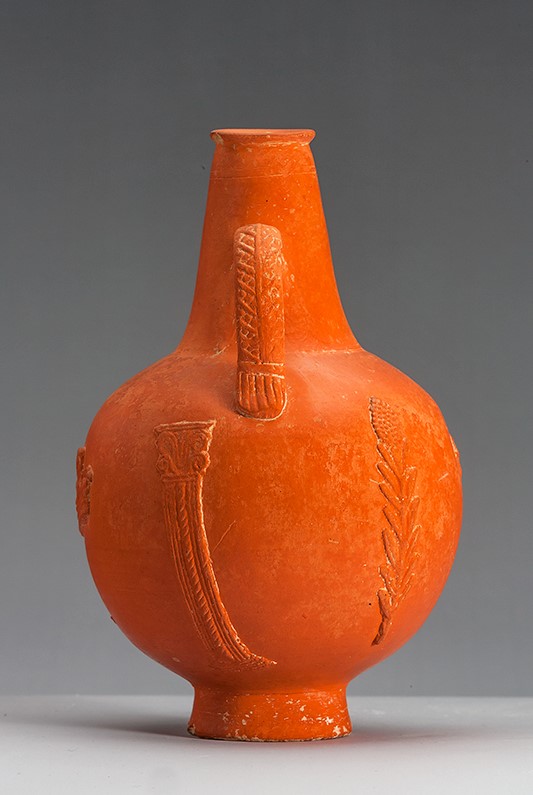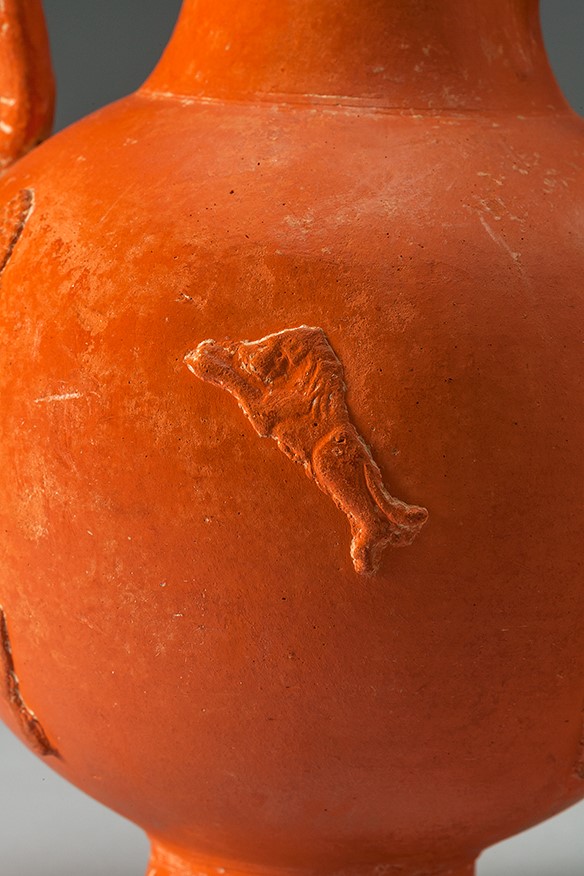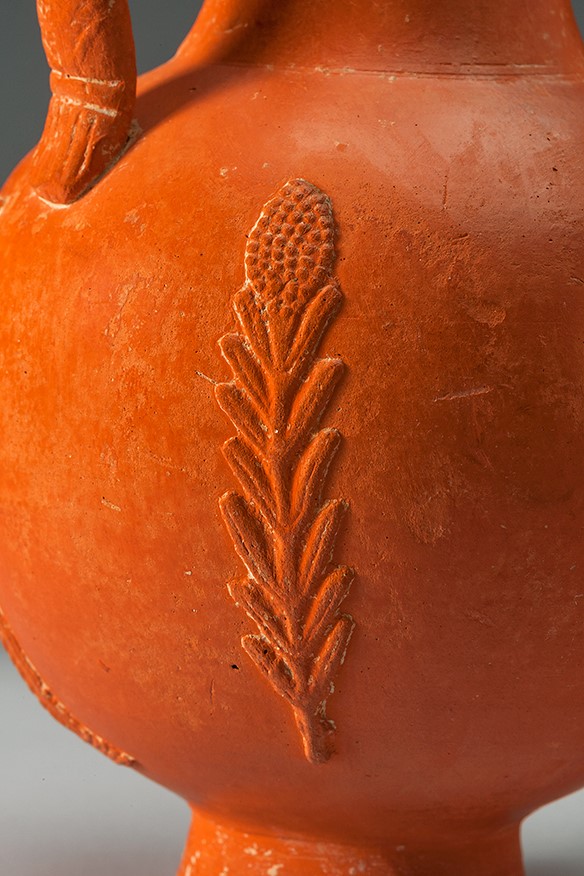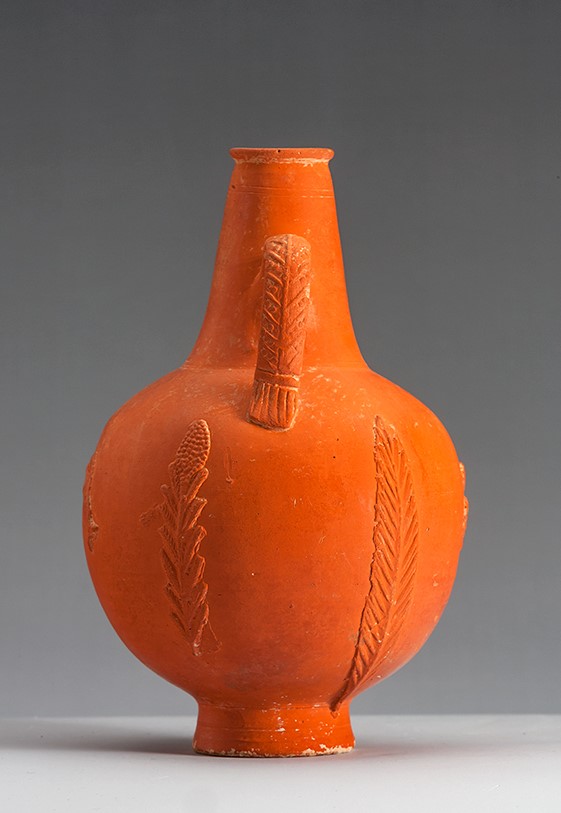Acquisition number: 1986.03
Globular body. Tapering neck with a mouth which has a rim projecting on the inside; it slopes down slightly into the mouth and has a rounded outer edge. There is a pair of incised lines on the neck a little below the mouth and another pair on the lower neck. Arching moulded handles running from lower neck to shoulder, with palm-leaves down the outer face and vertical strokes at the lower handle attachment. Fairly tall ring foot with a band of shallow grooves midway down the outer face. The inner face of the foot is cut in a straight oblique line. The underside of the floor is slightly convex.
On one side, in applied relief, is a leaping lion (to left) between date-palms. On the other side is a handled basket with birds set between a palm leaf and a pilaster. On the pilaster the capital is not unlike that of Corinthian but it has two levels of volutes; the shaft has central spiral fluting between verticals; the base is a series of steps.
The paint is a fairly lustrous orange-red; it is applied over all the outer faces and the underside, but there is no wash inside.
Title: African Red-Slip Flagon - 1986.03
Acquisition number: 1986.03
Author or editor: J.R. Green
Culture or period: Roman Imperial
Date: Mid 3rd century AD.
Material: Clay - Terracotta
Object type: Vessels - Flagon
Dimensions: 117mm (w) × 185mm (h)
Origin region or location: Tunisia
Display case or on loan: 12
Keywords: Roman, Imperial, Africa, Roman Africa
Charles Ede Ltd (London), Antiquities (25 Years) (1986) no. 16 (ill.).
1986.03
African Red-Slip Flagon
Purchased. Ht 18.5cm; diam. 11.7cm.
Intact and in good condition but for a little surface wear and some chips from the foot. There is some light incrustation about the resting surface and on the inner faces of the handles. The clay is difficult to see: pale brown, slightly rough in the break, with very fine inclusions.
Globular body. Tapering neck with a mouth which has a rim projecting on the inside; it slopes down slightly into the mouth and has a rounded outer edge. There is a pair of incised lines on the neck a little below the mouth and another pair on the lower neck. Arching moulded handles running from lower neck to shoulder, with palm-leaves down the outer face and vertical strokes at the lower handle attachment. Fairly tall ring foot with a band of shallow grooves midway down the outer face. The inner face of the foot is cut in a straight oblique line. The underside of the floor is slightly convex.
On one side, in applied relief, is a leaping lion (to left) between date-palms. On the other side is a handled basket with birds set between a palm leaf and a pilaster. On the pilaster the capital is not unlike that of Corinthian but it has two levels of volutes; the shaft has central spiral fluting between verticals; the base is a series of steps.
The paint is a fairly lustrous orange-red; it is applied over all the outer faces and the underside, but there is no wash inside.
The flagon is a good, characteristic example of African red-slip ware and the shape is a not uncommon one: cf. J.W. Hayes, Late Roman Pottery (Rome 1972) 195-7, Form 172 and especially pl. 9a. Its size puts it on the upper side of the normal range (ca 11.5 - 18cm). The form of the lip indicates that it must have been used for oil.
The vase belongs to a particular series known as El Ajoua Ware, named after the site in central Tunisia: see the pioneering article by J.W. Salomonson, “Etudes sur la céramique romaine d’Afrique”, Bulletin Antieke Beschaving 43, 1968, 80-145 (our vase is his shape VIII); and then the same author’s “Spätrömische rote Tonware mit Reliefverzierung aus nordafrikanischen Werkstätten. Entwicklungsgeschichtliche Untersuchungen zur reliefgeschmückten Terra Sigillata Chiara C”, Bulletin Antieke Beschaving 44, 1969, 4-109. M. Mackensen, “The Study of 3rd Century African Red Slip Ware based on the Evidence from Tunisia”, in: D. Malfitana, J. Poblome and J. Lund (eds), Old Pottery in a New Century. Innovating Perspectives on Roman Pottery Studies. Atti del convegno internazionale di studi. Catania, 22-24 aprile 2004 (Catania 2006) 105-124, gives a good presentation of the state of knowledge as of 2004 together with what were seen as current issues. One may note that he includes illustrations of the moulds for appliqués. For the later side of the sequence, see Mackensen, “Production of 3rd Century Sigillata A/C (C 1-2) or El-Aouja Ware and its Transition to Sigillata C³ with Appliqué Decoration in Central Tunisia”, Rei Cretariae Romanae Fautorum Acta 38, 2003, 279-286. For more general background, see Mackensen, “Reliefverzierte nordafrikanische Sigillata Chiara C und D in der Staatliche Sammlung Ägyptischer Kunst in München”, Archäologischer Anzeiger 1981, 522-536; “Produzione e diffusione della ceramica sigillata africana nella Tunisia centrale e settentrionale dalla metà del III secolo alla metà del V secolo d.C.”, in: M. De Vos (ed.), Archeologia del territorio. Metodi, materiali, prospettive. Medjerda e Adige. Due territori a confronto (Convegno internazionale di studio, Trento, 23-25 novembre 2000) (Trento 2004) 131-160, and M. Mackensen and G. Schneider, “Production Centres of African Red Slip Ware (2nd – 3rd c.) in Northern and Central Tunisia”, Journal of Roman Archaeology 19, 2006, 163-190, and now Mavkemsen’s “Technology and Organisation of ARS Ware Production-Centres in Tunisia”, in: J.H. Humprey (ed.), Studies on Roman Pottery of the Provinces of «Africa Proconsularis» and «Byzacena» (Tunisia). Hommage à Michel Bonifay (JRA Suppl. 76, Providence R.I., 2009) 17-44. In the same volume, note also J. Lund, “Methodological Constraints Affecting the Precise Dating of African Red Slip Ware”, 65-72 – an article with potentially wide application.
There is also a good and interesting article by M. Bonifay, “Production et diffusion des céramiques africaines durant l’antiquité tardive: modèles classiques, approches nouvelles”, in: R. Attoui (ed.), When Did Antiquity End? Archaeological Case Studies in Three Continents. The Proceedings of an International Seminar Held at the University of Trento on April 29-30, 2005 on Late Antique Societies, Religion, Pottery and Trade in Germania, Northern Africa, Greece and Asia Minor (Oxford 2011) 15-30, and more recently his “The Distribution of African Pottery under the Roman Empire: Evidence versus Interpretation”, in: A. Wilson & A. Bowman, Trade, Commerce, and the State in the Roman World (Oxford 2017) 327-352.
The appliqué decoration and its arrangement are characteristic: a single motif between two palm branches or the like. The character and significance of these motifs has not been fully investigated, but one may note that they are often animals associated with the hunt, birds and fish, or more commonly such creatures as panthers, leopards and lions which were better known from the venationes held in the amphitheatre, but which were not thereby excluded from the realm of private fantasy. Cf J.M. Demmarolle, “Imaginaires: le bestiaire de la sigillée ornée au Haut-Empire”, Dialogues d’Histoire Ancienne 19:2, 1993, 187-212, and now S. Tortorella, “Il repertorio iconografico della ceramica africana a rilievo del IV-V secolo d.C.”, in: Mélanges de l’Ecole française de Rome. Antiquité. Images en Relief: Iconographie et Ceramique (IVe siècle av. J.-C. - IVe siècle ap. J.-C.) (Rome 2005).
Similar figures appear as decoration on contemporary lamps: cf. E. Joly, Lucerne del Museo di Sabratha (Monografie di Archeologia Libica XI, Rome 1974) pl. 49ff. One may further compare our collection’s mosaic of a lion, also from Tunisia. For general background, see D.S. Potter and D.J. Mattingly, Life, Death, and Entertainment in the Roman Empire (Ann Arbor 1999).
Probably middle of the third century AD.
Charles Ede Ltd (London), Antiquities (25 Years) (1986) no. 16 (ill.).
